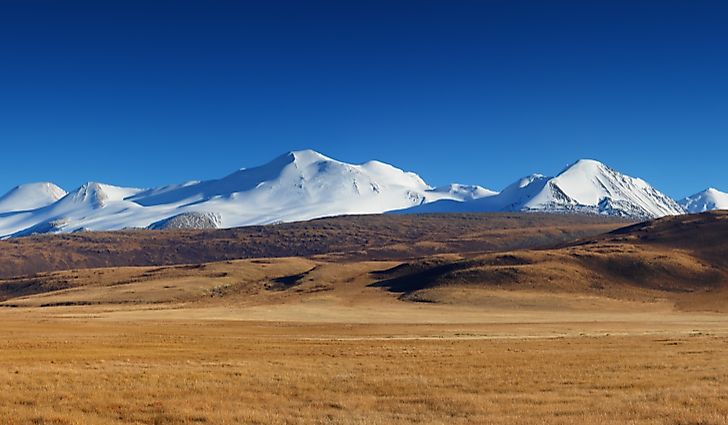Which Countries Border Mongolia?

Mongolia is the world's second-largest landlocked country. Archaeological evidence indicates that modern human societies have lived in Mongolia for more than 40,000 years and the long history of human habitation has dramatically affected the shape of the country's borders. Mongolia shares its land borders with China and Russia. Apart from Russia and China, the nation closest to Mongolia is Kazakhstan. Although the two nations do not share a common land boundary, they are only 23 miles apart at their closest points.
Border With China
China and Mongolia share a border that is roughly 2,877 miles long. China surrounds Mongolia on the southern, eastern, and western sections of the country. There are towns located on the Mongolian side of the border with some of the most notable being Sulanheer, Zamiin Uud, Chongol, and Hovuun. The towns situated on the Chinese side of the border include Baotou, Hohhot, and Datong. Several seasonal rivers cross the southern section of the China-Mongolia border, and on the Chinese side of the border, there are several water bodies such as the Gaxun Nur and the Sogo Nur. There are also several water bodies on the eastern side of the border with some of the most well-known being the Hulun Nur and the Buir Nur. On the eastern edge of Mongolia, the China-Mongolia border is often referred to as the Manchurian border as it marks the limits of the region often referred to as Manchuria. The Mongolia-China border also crosses through a section of the Gobi desert.
The Border Dispute With China
Mongolia and China were involved in a border dispute in 2016 due to the presence of the Dalai Lama in Mongolia. According to an article published by Aljazeera, the Chinese government closed one of the most crucial border crossing points roughly a week after the Dalai Lama had visited Mongolia. Experts believed that the Chinese government was punishing the Mongolian government for allowing the spiritual leader of Tibet to visit the country. The most significant impact of closing the crossing point was congestion particularly among large trucks that wanted to cross from one nation to the other. Apart from closing the border point, the Chinese government also put in place tariffs on goods moving between the two nations. Experts believe that if the relationship between the two nations deteriorates, it could hurt the Mongolian economy.
Historical Relationship With China
Throughout their shared history, Mongolia and China have had a remarkably complicated relationship. One of China's most famous features, the Great Wall of China, helped to ward off attacks from Mongolian invaders. One of the Mongolians who played a vital role in China's history was Kublai Khan, who was descendant of the most famous Mongolian leader, Genghis Khan. Kublai was credited with founding the Yuan Dynasty as well as bringing the entire nation of China under his control. The Chinese, under the Qing Dynasty, would later take control of Mongolia and their rule would last for more than 200 years. The fall of the Qing dynasty resulted in Mongolia gaining its independence as well as the establishment of the Republic of China.
Modern Relationship With China
In the modern era, China and Mongolia cooperate on several aspects with the most important ones being trade and development. The leaders of the two countries signed a treaty of cooperation in 1994 which bolstered the relationship. Data from both the Chinese and Mongolian governments indicates that within the first nine months of 2007 the value of goods traded between the two nations had already exceeded $1.13 billion. Because Mongolia is landlocked, the Chinese government had allowed Mongolia to use the Tianjin port to access the outside market.
Border With Russia
Mongolia and Russia share a border that is roughly 2,166 miles long and is situated on the northern edge of Mongolia. The present-day boundary between the two nations follows limits set out in a treaty by the Russian Empire and the Qing Empire referred to as the Treaty of Kyakhta. The original treaty ensured that the Tuva region remained within Mongolia's borders. However, after the Qing dynasty broke up, the region of Tuva broke away from Mongolia and fell under the control of the Russian government. The governments of Russia and Mongolia have set up ten official points along which people can legally cross from one nation to the other.
Issues Along The Border With Russia
One of the most significant issues along the border in 2005 between Mongolia and Russia was theft and smuggling. The most commonly stolen items were livestock which significantly affected the economy of Mongolia. The region that was most heavily affected was the Tuva.
Relationship With Russia
Russia and Mongolia have had generally positive ties that date back to the Soviet era. During this period, the government of the Soviet Union provided aid to the Mongolian nation. After the Soviet Union broke up, Mongolia and Russia still maintained close ties. In Mongolia, the Russian government is represented by an embassy situated in Ulaanbaatar as well as consulate generals located in Erdenet and Darkhan.
The Security Of The Mongolian Border
Border security is an essential issue to the government of Mongolia. The government has set up a department dedicated to safeguarding the border that is referred to as the General Authority of Border Protection and is under the Ministry of Justice. The Mongolian government relies heavily on techniques developed in the Soviet Union to keep its borders safe. Some sections of the Mongolian border have a fence to prevent unauthorized access.











